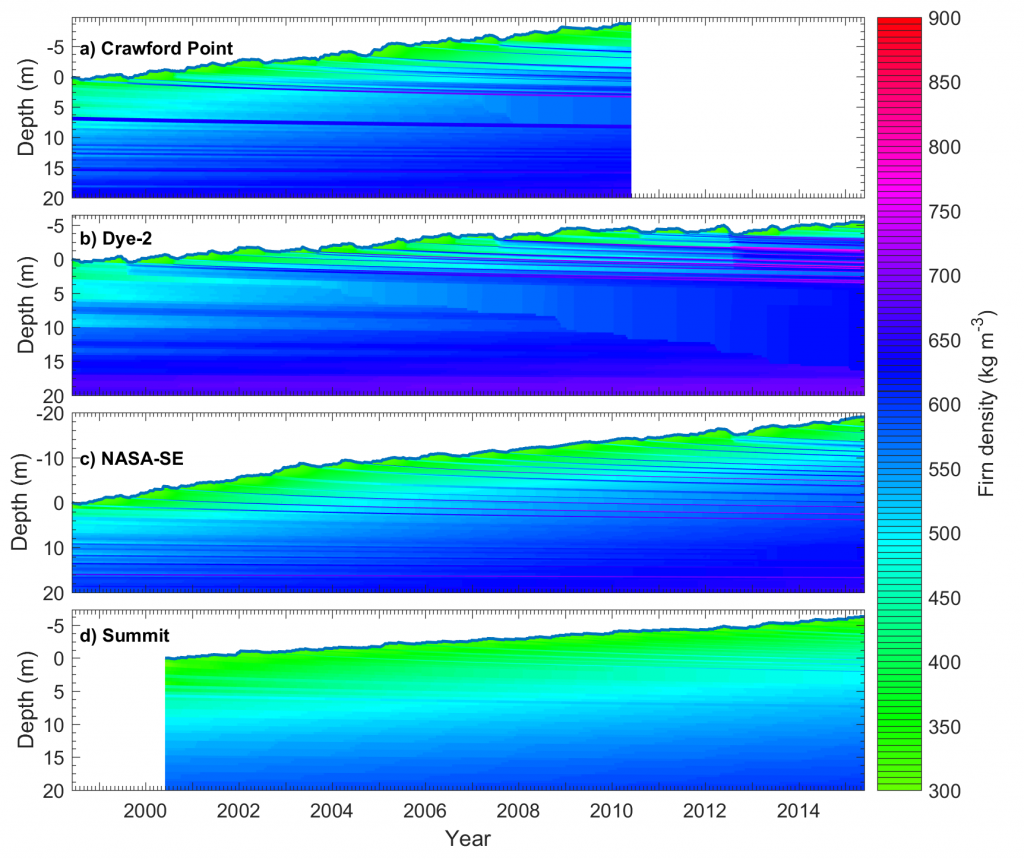We investigate the high-elevation firn plateau of the Greenland Ice Sheet in a new open-access study in the current issue of Journal of Geophysical Research1. This study pulls together singularly unique – and hard fought – ice core observations and weather station data into a super-neat firn model. This relatively porous near-surface ice-sheet layer known as firn is being increasingly scrutinized for two main reasons.
The first reason is sea-level rise. These high regions of the Greenland ice sheet are normally preserved form intense melting, but this is changing, with more melt seen in recent years. Nevertheless, the porosity of the firn can provide a buffer against sea-level rise when meltwater refreezes within the firn instead of running off into the ocean. But exactly how much of this buffering capacity is available – and for how long – is not really understood.
The second reason is satellite altimetry. Repeat observation of ice thickness by satellite altimeter is a primary method by which ice-sheet mass balance – or overall health – is assessed. But since firn is porous, changes in elevation don’t always translate into changes in mass. For example, the firn layer can become thinner – making the ice-sheet appear thinner – when there’s actually just an increase in firn density rather than a change in mass.

Figure 1 – Locations of the four study sites on the Greenland Ice Sheet’s high-elevation firn plateau.
In this study, we were interested in teasing out the climatic controls of firn density: What makes firn porosity grow and shrink over time? So, we simulated the evolution of firn density – and therefore porosity – over time at four ice-sheet sites. These sites were carefully chosen as sites where both in-situ climate and firn measurements were available (Crawford Point, Dye-2, NASA-SE and Summit). The firn simulations used an updated version of the HIRHAM regional climate model’s firn model. At each site, we initiated simulations using firn density profiles observed from ice cores, and then ran the simulations forward in time using in-situ weather station records. We then ensured that simulated firn density also compared well with repeat firn density profiles observed again many years later. The simulations were between 11 and 15 years, depending on the data available at each site.

Figure 2 – Simulated firn density through time at the four study sites. At all sites, the relative depth of a given layer increases over time, as snowfall exceeds meltwater runoff.
A lot of recent ice-sheet research has focused on how increasing air temperatures and meltwater production are increasing firn density. And our simulations definitely confirmed that! But perhaps counterintuitively, we found that the leading driver of changes in firn density was actually year-to-year changes in amount of snowfall. Firn density decreases as snowfall increases, and vice versa. This study therefore highlights that if we want to project time-and-space variability in firn density we really need to project time-and-space variability in snowfall rates.

Figure 3 – Assessing the relative strength of four drivers of firn density change at the four study sites.
It was also satisfying to see that – given observed climate data – our simulations could reproduce the firn conditions as observed in the field. This gives confidence including this firn model in regional climate models. This finding is of course limited to the high-elevation firn plateau of the Greenland Ice Sheet, which admittedly does not experience tremendous melt. But, as the firn plateau covers over 80% of the ice-sheet area, understanding it plays a key role in tackling pressing satellite altimetry and sea-level buffering questions.
This work is part of the Retain project funded by the Danmarks Frie Forskningsfond (grant 4002-00234). The open-access publication is available via the hyperlink below.
